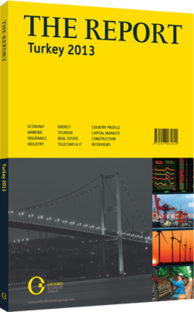Mark Lewis, Senior Resident Representative in Turkey, IMF, on the challenges and opportunities confronting the economy

The year 2013 is an important one for the Turkish economy, with many challenges and opportunities on the horizon. First, the sluggish global economy will likely remain a drag on Turkey’s growth this year, notably because of weak activity in the EU, a result of fiscal tightening in some countries and the uncertain outlook. Furthermore, several emerging markets have come down from the very high growth rates of earlier years, for example China and India, which will have repercussions for all countries, including Turkey.
Like other rapidly developing emerging markets, Turkey has seen its per capita GDP increase dramatically over the past decade, especially when measured in dollars. Looking ahead, emerging markets will still grow faster than developed economies, but not at such a rapid pace. And exchange rate effects are not likely to contribute as they did before to rising dollar-denominated GDP in emerging markets.
Turkey’s economy rebounded quickly from the sharp contraction in 2009 at the beginning of the global crisis, with GDP growth of 9.2% and 8.5% in 2010 and 2011, respectively. Those figures were very impressive, but they are unsustainable, leading to some macroeconomic imbalances, notably a high current-account deficit. The Turkish economy needed to slow down, and indeed it has. The growth rate for 2012 – estimated at 2.5% – may not be an impressive number, but it represents a welcome slowdown.
In fact, what Turkey needed was a “soft landing” – that is, a smooth unwinding of the imbalances caused by the unsustainably high growth rates, while still preserving stable macroeconomic conditions and increases in per capita income. And over the past year, the economy has indeed experienced a number of stabilising trends: slower growth in 2012 paired with some improvement in the current account deficit, slightly better quality of financing, lower inflation and encouraging employment figures.
At the IMF, we expect growth in Turkey to gradually pick up in 2013 and 2014, and then average between 4% and 4.5% over the medium term. This outlook represents a sustainable picture, underpinned by continued strong per capita growth, a manageable current account and moderate inflation.
Turkey will continue to face some challenges. Raising productivity levels will be crucial: as countries grow and industrialise, developing high-value-added industries and services becomes the next step toward higher standards of living. Turkey is now the 17th-largest economy in the world in nominal terms, and catching up with bigger economies such as South Korea will require a substantial relative increase in GDP.
The good news is that Turkey’s fundamentals are robust. The economy is characterised by a very dynamic private sector. And household, state, private sector and bank debt levels are generally low, which is a source of resilience in the face of possible future systemic shocks. However, although debt levels are low, much of Turkey’s debt is short-term. This implies high rollover needs and continued financing requirements.
Reducing these financing needs will ultimately require a boost in savings. The importance of savings is linked to growth and financing: growth requires investment, and investment has to be financed, either by domestic or foreign savings. If domestic savings are insufficient, then foreign savings are needed, entering Turkey as foreign capital. Thus, it will be important to increase domestic savings, as this will allow higher levels of investment for growth, and reduce Turkey’s dependence on foreign capital.
A final area that we expect will be both a challenge and opportunity for Turkey is trade diversification.
While the EU remains Turkey’s largest trade partner, other regions – most notably the Middle East and North Africa – are rising in importance. However, Turkey’s trade with Asia remains quite low, especially regarding Turkish exports. Continuing to diversify trade, and in particular to regions where Turkey currently has low levels of market penetration, will be an important challenge to overcome in the period ahead.
You have reached the limit of premium articles you can view for free.
Choose from the options below to purchase print or digital editions of our Reports. You can also purchase a website subscription giving you unlimited access to all of our Reports online for 12 months.
If you have already purchased this Report or have a website subscription, please login to continue.

